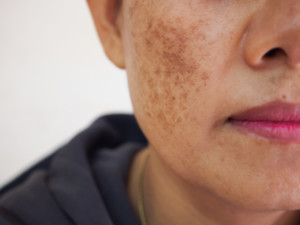By Gigi Spencer, L.E.
I commonly encounter clients presenting melasma and I suffer from melasma myself. What is Melasma? It is a chronic skin condition also known as Chloasma, in which brown patches appear on the face — specifically the cheeks, forehead, nose and chin and upper lip — but sometimes it can also appear on the body. It is most often thought to just be hyperpigmentation but can be caused by hormonal changes during pregnancy or from exposure to UV (ultraviolet) rays from the sun, which stimulates the melanocytes. Melasma can be caused by genetics, skin inflammation, and irritation from products, and it can even be caused by contraceptives or IUDs.
Women are more likely to get melasma but men can also have it. It can improve or fade on its own or after going off birth control, however there is no cure. 

Sometimes melasma can be stubborn, and you must be diligent and have patience, but with the use of topical lightening creams and skin care products: chemical peels, low energy light based procedures, microneedling, microdermabrasion or oral products to slow melanin production, you may find a solution. These treatments should only be done by a licensed skin care professional. It is very important to reinforce these procedures and treatments by protecting the skin with a broad spectrum SPF, because those harmful sun rays can make your melasma worse. Treatments should also be reinforced with limited sun exposure during peak hours, and wearing wide brimmed hats while outdoors. UV blockers such as iron oxide and titanium dioxide lower chances of reoccurring melasma or flare-ups. I also find that increasing my water intake and keeping up with my skin care regimen helps the process.

